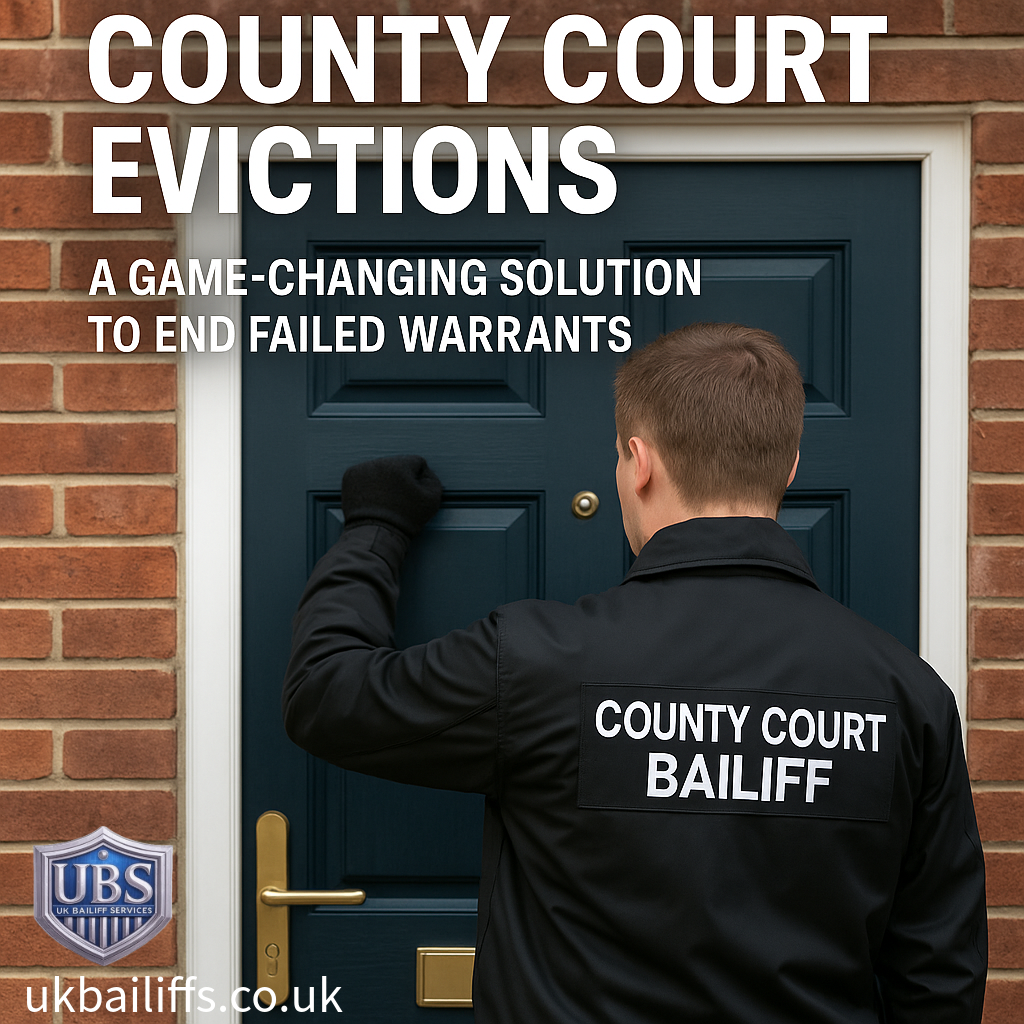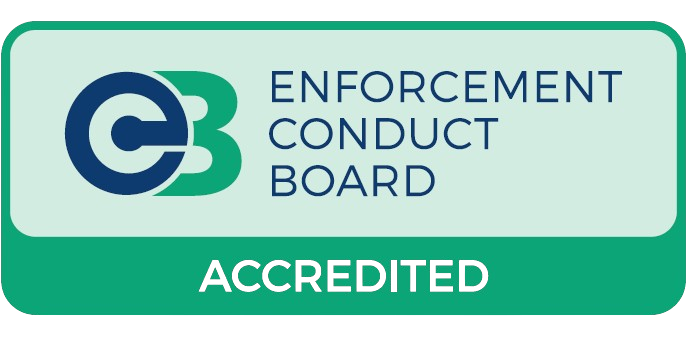🚨 County Court Evictions: A Game-Changing Solution to End Failed Warrants
Why formalising certificated enforcement support is the key to fair, safe, and effective evictions

The Crisis in County Court Evictions
Every year, thousands of landlords in England and Wales secure lawful possession orders, only to face a harsh reality: County Court Bailiffs (CCBs), constrained by backlogs and increasingly cautious operational approaches around vulnerability and safety, sometimes leave warrants unenforced. Landlords are left out of pocket — in London, average losses exceed £19,000 , with national averages around £12,700.
GOV.UK confirms the two distinct routes: County Court warrants are enforced by CCBs, while writs of possession are enforced by HCEOs ( Eviction notices & bailiffs ; CPR Part 83 ).
Where UK Bailiff Services Ltd Fits
We regularly attend with County Court Bailiffs to support landlords on warrant day. Under a County Court warrant we have no independent powers and act entirely under the CCB’s direction. Our role includes:
- De-escalation and clear communication with occupants
- Pre-attendance liaison and logistics, including locksmith/police where appropriate
- On-site manpower to clear safe exits and re-secure premises
- Body-worn video and structured notes to support safeguarding
A Practical, No-Law-Change Solution
1) HMCTS Panel of “CCB Assist Teams”
HMCTS could panel vetted certificated EA firms nationally — analogous to locksmith arrangements — but with:
- ECB -aligned standards and welfare-first training
- Mandatory body-worn video and incident reporting
- Clear indemnities and oversight
2) Practice Direction Pilot under CPR Part 83
A short Practice Direction pilot could authorise CCBs, where resistance or vulnerability is anticipated, to list named certificated EAs on the EX97A/EX97 risk forms as “appointed assistants”:
- Direction and control remain with the CCB at all times
- Assistants may perform specified acts on CCB instruction (positioning, communication, clearing exits, securing property, safeguarding notes) — not the core act of eviction
- Aligns with HMCTS’s Vulnerability Action Plan focus on improved processes for vulnerable users
Why This Matters
| Landlords
Reduce re-listings and losses (typical arrears/loss at eviction: £12.7k–£19.2k ). |
County Court Bailiffs
Extra hands for safety and logistics; fewer withdrawals. |
| Tenants (incl. vulnerable)
De-escalation, transparent recording, safeguarding first. |
HMCTS & Judiciary
Operational resilience; fewer failed attendances; public confidence. |
Call to Action
We invite District Judges, HMCTS officials, housing providers and enforcement professionals to support a six-month pilot in backlog-heavy circuits. If CCBs are expected to enforce with minimal force, they should not be expected to enforce without adequate support.
FAQ
What is a Practice Direction?
A Practice Direction (PD) is official guidance that supplements the Civil Procedure Rules (CPR). PDs explain how the rules should be applied in practice and can create pilot procedures. They are published on the Ministry of Justice website and sit alongside the CPR. See Civil Procedure Rules & Practice Directions.
What is CPR Part 83?
CPR Part 83 sets out the framework for executing writs and warrants, including warrants of possession (County Court Bailiffs) and writs of possession (HCEOs). It covers general provisions for enforcement, procedure, and related practice directions. Read: CPR Part 83 and Practice Direction 83.
What is the difference between County Court Bailiffs and Certificated Enforcement Agents?
County Court Bailiffs (CCBs) are HMCTS officers who enforce warrants of possession issued by the County Court. Certificated Enforcement Agents (EAs) are privately employed agents certified under the Tribunals, Courts and Enforcement Act 2007 , typically empowered to take control of goods (debt enforcement). EAs do not have independent authority to execute a County Court warrant of possession; they may assist under a bailiff’s direction, or work with an HCEO on a writ of possession. See GOV.UK: Eviction notices & bailiffs and Your rights and bailiffs.
Can what is proposed become reality?
Yes. Two realistic routes:
- Policy/Operations: HMCTS can panel vetted certificated firms as CCB Assist Teams (similar to locksmith arrangements) with standards, reporting and indemnities.
- Practice Direction (Pilot): A short PD under CPR Part 83 could authorise CCBs to list named certificated EAs on EX97A/EX97 as appointed assistants , acting only under CCB direction.
This requires no statutory change and aligns with current policy goals on vulnerability management. Related context: HCEOA transfer-up report and Propertymark summary.
Open Letter to HMCTS, Judiciary, Housing Associations, and Enforcement Stakeholders
Dear Colleagues,
At UK Bailiff Services Ltd, we see daily the operational pressures facing landlords, tenants, and County Court Bailiffs (CCBs) in the enforcement of lawful possession orders. Court backlogs and operational caution around risk and vulnerability frequently delay or disrupt enforcement. Reported arrears at the point of eviction average around £12,700 nationally and £19,200 in London. Meanwhile, the High Court Enforcement Officers Association (HCEOA) survey (Oct 2025) indicates that in London only ~30% of applications to transfer to the High Court were approved — leaving most cases to proceed via the County Court route.
Our objective is straightforward: uphold dignity, welfare considerations, and due process for occupants, while ensuring court orders are practically enforceable.
Systemic Context (Evidence-led)
- Two enforcement routes. County Court warrants are enforced by CCBs; writs of possession are enforced by High Court Enforcement Officers (HCEOs). These are distinct in process and law. See GOV.UK overview: Eviction notices and bailiffs and CPR Part 83: Writs & Warrants — general provisions.
- Operational caution. Reports suggest that where resistance or vulnerability is anticipated, CCBs may take a risk-averse approach and withdraw to be relisted. This aligns with the HMCTS Vulnerability Action Plan emphasis on safeguarding.
- Transfer-up limited. In London, ~70% of reported transfer-up applications were refused (HCEOA survey), reducing the “safety valve” many relied upon.
Our Current Role (and Its Limits)
We regularly attend with County Court Bailiffs to support warrant days. Under a County Court warrant, our certificated enforcement agents (EAs) have no independent eviction powers and act solely under the authority and direction of the CCB. In practice, our teams assist with de-escalation and communication, pre-attendance planning and liaison (e.g., locksmith/police where appropriate), on-site logistics (clearing safe exits, re-securing premises post-entry), and transparent record-keeping (including body-worn video) to support safeguarding. This support is valuable — yet informal. When risks escalate, the absence of a formal support framework can still lead to withdrawal and relisting.
Practical Proposal (No Change in Powers)
1) HMCTS Panel of “CCB Assist Teams”
We propose that HMCTS panel vetted, certificated EA firms nationally — similar in spirit to locksmith arrangements — with reinforced guardrails:
- Standards & training: Compliance with the Enforcement Conduct Board (ECB) guidance; welfare-first practice aligned with the HMCTS Vulnerability Action Plan.
- Transparency: Mandatory body-worn video and structured reporting to support accountability.
- Oversight & indemnities: Clear terms confirming direction remains with the CCB, plus appropriate liability and insurance provisions.
2) Practice Direction Pilot under CPR Part 83
Introduce a short Practice Direction (PD) pilot under CPR Part 83 allowing CCBs, where resistance or vulnerability is anticipated, to list named certificated EAs on EX97A/EX97 risk forms as “appointed assistants.”
- Authority preserved: Direction and control remain with the County Court Bailiff at all times.
- Defined tasks only: Assistants may, on instruction, handle positioning, communication with occupants, clearing safe exits, securing premises, and safeguarding notes — not the core act of eviction.
- Safeguarding aligned: The model dovetails with HMCTS vulnerability priorities, adding trained personnel to de-escalate and document sensitive situations.
Benefits to All Stakeholders
- Landlords: Fewer withdrawals and relistings; reduced arrears and damage by bringing cases to a conclusion once orders are made.
- Tenants and Occupants: Dignity, welfare considerations, and due process supported by trained personnel and transparent evidence capture.
- County Court Bailiffs: Operational support for safety and logistics while retaining full legal authority.
- HMCTS & Judiciary: Reduced operational friction and improved confidence in the enforceability of court orders.
Anticipated Questions & Safeguards
- Is this privatisation? No. CCBs retain 100% authority. Assistants act only under instruction, for non-core tasks that support safety and process integrity.
- What about liability and standards? The panel model would include clear terms, ECB-aligned standards, mandatory reporting, and appropriate indemnities/insurance.
- Is new legislation required? No statutory change is proposed. The PD pilot would test operational improvements within the existing CPR framework.
Invitation to Collaborate
We welcome a roundtable with HMCTS operations, Designated Civil Judges, housing sector bodies, and enforcement stakeholders to refine and test this approach over a six-month pilot in backlog-affected circuits. Our objective is shared: treat occupants with dignity and safeguard them appropriately, while ensuring that a court order leads to a lawful and safe outcome.
If court orders are to retain meaning, they must be practically enforceable — fairly, safely, and with clear accountability.
Sincerely,
UK Bailiff Services Ltd
help@ukbailiffs.org
· 0330 133 1818
· ukbailiffs.co.uk
Reference Appendix (links)
- HCEOA — “Possessions: Transferring Up (Oct 2025)” (survey indicating ~30% approvals in London): Report PDF
- HCEOA — Research on County Court delays and arrears at eviction: Summary
- Propertymark — Support for transfer-up options: Article
- GOV.UK — Eviction notices and bailiffs (route overview): Guidance
- CPR — Part 83, Writs & Warrants (general provisions): Rules · Practice Direction 83: PD
- HMCTS — Vulnerability Action Plan: Policy
- Form — EX97A risk assessment (GOV.UK): EX97A · PDF: Download



